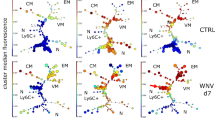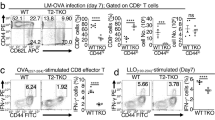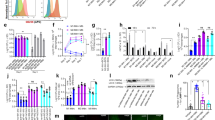Abstract
Mice deficient in the interferon-γ (IFN-γ)-inducible, immunity-related GTPase Irgm1 have defective host resistance to a variety of intracellular pathogens. This greater susceptibility to infection is associated with impaired IFN-γ-dependent macrophage microbicidal activity in vitro. Here we show that Irgm1 also regulated the survival of mature effector CD4+ T lymphocytes by protecting them from IFN-γ-induced autophagic cell death. Mice deficient in both IFN-γ and Irgm1 were 'rescued' from the lymphocyte depletion and greater mortality that occurs in mice singly deficient in Irgm1 after mycobacterial infection. Our studies identify a feedback mechanism in the T helper type 1 response that limits the detrimental effects of IFN-γ on effector T lymphocyte survival while promoting the antimicrobial functions of IFN-γ.
This is a preview of subscription content, access via your institution
Access options
Subscribe to this journal
Receive 12 print issues and online access
$209.00 per year
only $17.42 per issue
Buy this article
- Purchase on Springer Link
- Instant access to full article PDF
Prices may be subject to local taxes which are calculated during checkout





Similar content being viewed by others
Change history
05 October 2008
In the version of this article initially published online, the genotype is missing in the first subheading of the Results section. The correct subheading is “Impaired expansion of activated Irgm1?/? CD4+ T cell populations.” The error has been corrected for the print, PDF and HTML versions of this article.
References
Gett, A.V., Sallusto, F., Lanzavecchia, A. & Geginat, J. T cell fitness determined by signal strength. Nat. Immunol. 4, 355–360 (2003).
Khoruts, A., Mondino, A., Pape, K.A., Reiner, S.L. & Jenkins, M.K. A natural immunological adjuvant enhances T cell clonal expansion through a CD28-dependent, interleukin (IL)-2-independent mechanism. J. Exp. Med. 187, 225–236 (1998).
Croft, M. Co-stimulatory members of the TNFR family: keys to effective T-cell immunity? Nat. Rev. Immunol. 3, 609–620 (2003).
Krammer, P.H., Arnold, R. & Lavrik, I.N. Life and death in peripheral T cells. Nat. Rev. Immunol. 7, 532–542 (2007).
Green, D.R. Fas Bim boom! Immunity 28, 141–143 (2008).
Shimizu, S. et al. Role of Bcl-2 family proteins in a non-apoptotic programmed cell death dependent on autophagy genes. Nat. Cell Biol. 6, 1221–1228 (2004).
Yu, L. et al. Regulation of an ATG7-beclin 1 program of autophagic cell death by caspase-8. Science 304, 1500–1502 (2004).
Levine, B. & Yuan, J. Autophagy in cell death: an innocent convict? J. Clin. Invest. 115, 2679–2688 (2005).
Maiuri, M.C., Zalckvar, E., Kimchi, A. & Kroemer, G. Self-eating and self-killing: crosstalk between autophagy and apoptosis. Nat. Rev. Mol. Cell Biol. 8, 741–752 (2007).
Espert, L. et al. Autophagy is involved in T cell death after binding of HIV-1 envelope proteins to CXCR4. J. Clin. Invest. 116, 2161–2172 (2006).
Pua, H.H., Dzhagalov, I., Chuck, M., Mizushima, N. & He, Y.W. A critical role for the autophagy gene Atg5 in T cell survival and proliferation. J. Exp. Med. 204, 25–31 (2007).
Vella, A.T., McCormack, J.E., Linsley, P.S., Kappler, J.W. & Marrack, P. Lipopolysaccharide interferes with the induction of peripheral T cell death. Immunity 2, 261–270 (1995).
Wu, C.Y. et al. Distinct lineages of TH1 cells have differential capacities for memory cell generation in vivo. Nat. Immunol. 3, 852–858 (2002).
Whitmire, J.K., Benning, N. & Whitton, J.L. Cutting edge: early IFN-γ signaling directly enhances primary antiviral CD4+ T cell responses. J. Immunol. 175, 5624–5628 (2005).
Liu, Y. & Janeway, C.A. Jr. Interferon γ plays a critical role in induced cell death of effector T cell: a possible third mechanism of self-tolerance. J. Exp. Med. 172, 1735–1739 (1990).
Refaeli, Y., Van Parijs, L., Alexander, S.I. & Abbas, A.K. Interferon γ is required for activation-induced death of T lymphocytes. J. Exp. Med. 196, 999–1005 (2002).
Chu, C.Q., Wittmer, S. & Dalton, D.K. Failure to suppress the expansion of the activated CD4 T cell population in interferon γ-deficient mice leads to exacerbation of experimental autoimmune encephalomyelitis. J. Exp. Med. 192, 123–128 (2000).
Dalton, D.K., Haynes, L., Chu, C.Q., Swain, S.L. & Wittmer, S. Interferon γ eliminates responding CD4 T cells during mycobacterial infection by inducing apoptosis of activated CD4 T cells. J. Exp. Med. 192, 117–122 (2000).
Bach, E.A. et al. Ligand-induced autoregulation of IFN-γ receptor β chain expression in T helper cell subsets. Science 270, 1215–1218 (1995).
Pernis, A. et al. Lack of interferon γ receptor β chain and the prevention of interferon γ signaling in TH1 cells. Science 269, 245–247 (1995).
Sorace, J.M., Johnson, R.J., Howard, D.L. & Drysdale, B.E. Identification of an endotoxin and IFN-inducible cDNA: possible identification of a novel protein family. J. Leukoc. Biol. 58, 477–484 (1995).
Boehm, U. et al. Two families of GTPases dominate the complex cellular response to IFN-γ. J. Immunol. 161, 6715–6723 (1998).
Taylor, G.A., Feng, C.G. & Sher, A. p47 GTPases: regulators of immunity to intracellular pathogens. Nat. Rev. Immunol. 4, 100–109 (2004).
MacMicking, J.D., Taylor, G.A. & McKinney, J.D. Immune control of tuberculosis by IFN-γ-inducible LRG-47. Science 302, 654–659 (2003).
Singh, S.B., Davis, A.S., Taylor, G.A. & Deretic, V. Human IRGM induces autophagy to eliminate intracellular mycobacteria. Science 313, 1438–1441 (2006).
Feng, C.G. et al. Mice deficient in LRG-47 display increased susceptibility to mycobacterial infection associated with the induction of lymphopenia. J. Immunol. 172, 1163–1168 (2004).
Santiago, H.C. et al. Mice deficient in LRG-47 display enhanced susceptibility to Trypanosoma cruzi infection associated with defective hemopoiesis and intracellular control of parasite growth. J. Immunol. 175, 8165–8172 (2005).
Feng, C.G., Weksberg, D.C., Taylor, G.A., Sher, A. & Goodell, M.A. The p47 GTPase Lrg-47 (Irgm1) links host defense and hematopoietic stem cell proliferation. Cell Stem Cell 2, 83–89 (2008).
Winslow, G.M., Roberts, A.D., Blackman, M.A. & Woodland, D.L. Persistence and turnover of antigen-specific CD4 T cells during chronic tuberculosis infection in the mouse. J. Immunol. 170, 2046–2052 (2003).
Doherty, T.M. & Sher, A. Defects in cell-mediated immunity affect chronic, but not innate, resistance of mice to Mycobacterium avium infection. J. Immunol. 158, 4822–4831 (1997).
Florido, M. et al. Gamma interferon-induced T-cell loss in virulent Mycobacterium avium infection. Infect. Immun. 73, 3577–3586 (2005).
Pearce, E.J. & MacDonald, A.S. The immunobiology of schistosomiasis. Nat. Rev. Immunol. 2, 499–511 (2002).
Liang, X.H. et al. Induction of autophagy and inhibition of tumorigenesis by beclin 1. Nature 402, 672–676 (1999).
Xu, Y., Kim, S.O., Li, Y. & Han, J. Autophagy contributes to caspase-independent macrophage cell death. J. Biol. Chem. 281, 19179–19187 (2006).
Foulds, K.E. et al. IFN-γ mediates the death of Th1 cells in a paracrine manner. J. Immunol. 180, 842–849 (2008).
Li, X., McKinstry, K.K., Swain, S.L. & Dalton, D.K. IFN-γ acts directly on activated CD4+ T cells during mycobacterial infection to promote apoptosis by inducing components of the intracellular apoptosis machinery and by inducing extracellular proapoptotic signals. J. Immunol. 179, 939–949 (2007).
Bronte, V., Serafini, P., Mazzoni, A., Segal, D.M. & Zanovello, P. L-arginine metabolism in myeloid cells controls T-lymphocyte functions. Trends Immunol. 24, 302–306 (2003).
Mellor, A.L. & Munn, D.H. Creating immune privilege: active local suppression that benefits friends, but protects foes. Nat. Rev. Immunol. 8, 74–80 (2008).
Van De Wiele, C.J. et al. Loss of interferon-induced Stat1 phosphorylation in activated T cells. J. Interferon Cytokine Res. 24, 169–178 (2004).
Alexander, W.S. et al. SOCS1 is a critical inhibitor of interferon γ signaling and prevents the potentially fatal neonatal actions of this cytokine. Cell 98, 597–608 (1999).
Egwuagu, C.E. et al. Suppressors of cytokine signaling proteins are differentially expressed in Th1 and Th2 cells: implications for Th cell lineage commitment and maintenance. J. Immunol. 168, 3181–3187 (2002).
Chong, M.M., Metcalf, D., Jamieson, E., Alexander, W.S. & Kay, T.W. Suppressor of cytokine signaling-1 in T cells and macrophages is critical for preventing lethal inflammation. Blood 106, 1668–1675 (2005).
Brysha, M. et al. Suppressor of cytokine signaling-1 attenuates the duration of interferon γ signal transduction in vitro and in vivo. J. Biol. Chem. 276, 22086–22089 (2001).
Platanias, L.C. Mechanisms of type-I- and type-II-interferon-mediated signalling. Nat. Rev. Immunol. 5, 375–386 (2005).
van Boxel-Dezaire, A.H. & Stark, G.R. Cell type-specific signaling in response to interferon-γ. Curr. Top. Microbiol. Immunol. 316, 119–154 (2007).
Levine, B. & Deretic, V. Unveiling the roles of autophagy in innate and adaptive immunity. Nat. Rev. Immunol. 7, 767–777 (2007).
Mizushima, N., Levine, B., Cuervo, A.M. & Klionsky, D.J. Autophagy fights disease through cellular self-digestion. Nature 451, 1069–1075 (2008).
Gutierrez, M.G. et al. Autophagy is a defense mechanism inhibiting BCG and Mycobacterium tuberculosis survival in infected macrophages. Cell 119, 753–766 (2004).
Gonda, M.A., Aaronson, S.A., Ellmore, N., Zeve, V.H. & Nagashima, K. Ultrastructural studies of surface features of human normal and tumor cells in tissue culture by scanning and transmission electron microscopy. J. Natl. Cancer Inst. 56, 245–263 (1976).
Acknowledgements
We thank G. Taylor (Duke University) for Irgm1−/− mice backcrossed more than 12 times to C57BL/6 mice; S. White, C. Henry and C. Eigsti for technical assistance; J. Zhu and L. Yu for advice and discussions; K. Nagashima (Electron Microscope Facility, Image Analysis Laboratory, Science Applications International Corporation–National Cancer Institute, Frederick) for the electron microscopy studies; A. Cheever (Biomedical Research Institute) for assessing tissue fibrosis and pathology in S. mansoni infection experiments; R. Donnelly (Center for Biologics Evaluation and Research, Food and Drug Administration) for initial help in measuring STAT1 phosphorylation; and H. Young and D.L. Barber for critical reading of the manuscript. Supported by the Intramural Research Program of the National Institute of Allergy and Infectious Diseases, National Institutes of Health, Department of Health and Human Services.
Author information
Authors and Affiliations
Contributions
C.G.F. designed the study, did research, analyzed results and wrote the manuscript; A.S. directed the study and wrote the manuscript; L.Z. and M.J.L. designed experiments, did research, analyzed results and contributed to the preparation of the manuscript; D.J., A.B., J.L.C., W.T.W., D.C. and P.L.S. did research and analyzed results; and S.H., and P.C. did research.
Corresponding author
Supplementary information
Supplementary Text and Figures
Supplementary Figures 1–9, Table 1 and Methods (PDF 6293 kb)
Rights and permissions
About this article
Cite this article
Feng, C., Zheng, L., Jankovic, D. et al. The immunity-related GTPase Irgm1 promotes the expansion of activated CD4+ T cell populations by preventing interferon-γ-induced cell death. Nat Immunol 9, 1279–1287 (2008). https://doi.org/10.1038/ni.1653
Received:
Accepted:
Published:
Issue Date:
DOI: https://doi.org/10.1038/ni.1653
This article is cited by
-
Therapeutic potential of autophagy in immunity and inflammation: current and future perspectives
Pharmacological Reports (2023)
-
Irgm1 regulates metabolism and function in T cell subsets
Scientific Reports (2022)
-
Loss of the interferon-γ-inducible regulatory immunity-related GTPase (IRG), Irgm1, causes activation of effector IRG proteins on lysosomes, damaging lysosomal function and predicting the dramatic susceptibility of Irgm1-deficient mice to infection
BMC Biology (2016)
-
Immunomodulatory and anticancer potential of Gan cao (Glycyrrhiza uralensis Fisch.) polysaccharides by CT-26 colon carcinoma cell growth inhibition and cytokine IL-7 upregulation in vitro
BMC Complementary and Alternative Medicine (2016)
-
Mice lack of LRG-47 display the attenuated outcome of infection with Schistosoma japonicum
Parasitology Research (2016)



